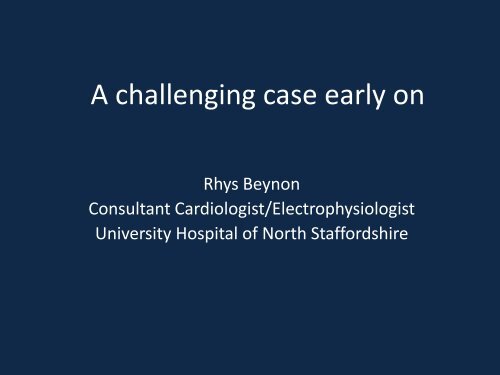Dr R Beynon University Hospital of North Staffordshire
Dr R Beynon University Hospital of North Staffordshire
Dr R Beynon University Hospital of North Staffordshire
You also want an ePaper? Increase the reach of your titles
YUMPU automatically turns print PDFs into web optimized ePapers that Google loves.
A challenging case early on<br />
Rhys <strong>Beynon</strong><br />
Consultant Cardiologist/Electrophysiologist<br />
<strong>University</strong> <strong>Hospital</strong> <strong>of</strong> <strong>North</strong> <strong>Staffordshire</strong>
• 19 year old male<br />
Background<br />
• Long history <strong>of</strong> palpitations<br />
• No other PMH<br />
• Fit and well
12 Lead ECG
1. L posterior<br />
Where is the pathway?<br />
2. L posteroseptal<br />
3. R posteroseptal<br />
4. R posterior<br />
5. Mid septal<br />
20% 20% 20% 20% 20%<br />
1 2 3 4 5
Anterograde curve
Start <strong>of</strong> antidromic tachycardia
Antidromic tachycardia with CL<br />
230msec
Attempted termination <strong>of</strong> tachycardia<br />
with V pacing
Shortest RR interval in AF<br />
160 msec
Management<br />
• Attempted to sedate patient to DC cardiovert<br />
– 13 mg midazolam / 100 mcg fentanyl – still awake<br />
• On call anaesthetist fast bleeped<br />
– SHO arrived after 10 mins and stated he was<br />
actually an acute medical trainee on an<br />
anaesthetic attachment, wasn’t happy to put pt<br />
asleep and went to phone consultant
Management<br />
• 3 External DC shocks with 150J biphasic by lab<br />
staff ( I was out <strong>of</strong> lab trying to get hold <strong>of</strong> an<br />
anaesthetist )<br />
– Failed to cardiovert to SR<br />
• Rolled patient over – pads changed to AP<br />
– First 150 J shock failed to cardiovert<br />
– Second shock cardioverted to SR
Which investigation has not been shown to be<br />
associated with a risk <strong>of</strong> sudden death during EP testing<br />
WPW?<br />
1. Inducibility <strong>of</strong><br />
tachycardia (AVRT/AF)<br />
2. Shortest RR interval in<br />
AF < 250 msec<br />
3. Anterograde ERP <strong>of</strong><br />
pathway < 250 msec<br />
4. Anterograde ERP <strong>of</strong><br />
pathway
Clinical course<br />
• Pt spontaneously went into AF again soon<br />
after cardioversion from VF<br />
• 100mg Flecainide given – AF rate slowed<br />
• Phoned a friend …………<br />
– Colleague found to give a hand
Management<br />
• Consultant anaesthetist found unwilling to<br />
commit to supporting the case for prolonged<br />
period due to staffing issues<br />
– options<br />
• 1. Attempt to ablate pathway in AF<br />
• 2. Ask anaesthetist for short GA to cardiovert to<br />
SR accepting he may well go into AF again<br />
• 3. Stop case and admit until full GA case a<br />
possibility
Management<br />
• Initial attempt to ablate in AF – failed<br />
– Unable to map<br />
– Lesson learnt – this is very difficult to do!<br />
• Short GA given – returned to SR
What set up for ablation?<br />
1. Standard RF<br />
catheter<br />
2. Cool tip RF catheter<br />
3. Cryo cath<br />
4. Standard RF<br />
catheter with<br />
Sheath<br />
5. Cool tip cath with<br />
sheath<br />
20% 20% 20% 20% 20%<br />
1 2 3 4 5
Pathway mapped to between 6 and 7<br />
o’clock on TV annulus
Case terminated 5 hours after starting<br />
Unable to ablate pathway<br />
1. Admit and bring<br />
back to lab prior to<br />
discharge<br />
2. Discharge on<br />
antiarrhythmic for<br />
repeat endocardial<br />
ablation<br />
3. Discharge and bring<br />
back for epicardial<br />
ablation<br />
33% 33% 33%<br />
1 2 3
Management<br />
• Pt discharged with regular flecainide<br />
• Readmitted for planned GA case 2 months<br />
later<br />
• 3 consultant procedure, myself, colleague and<br />
visiting consultant with epicardial experience
EPS and attempted ablation<br />
• TV annulus remapped with SRO sheath, F curve cool tip catheter<br />
• AF spontaneously induced with degeneration to VF – cardioverted<br />
to SR<br />
• Prolonged mapping at TV annulus with early signals at 6 o’clock.<br />
• Multiple ablations with occasional suggestion <strong>of</strong> a change in the<br />
degree <strong>of</strong> pre-excitation.<br />
• Good signals up to 40 msec ahead <strong>of</strong> delta over a reasonably wide<br />
area.<br />
• Eventually exchanged SR0 for an Agilis sheath to get better contact<br />
and perform<br />
• Further ablation without success.
Epicardial access gained
Epicardial ablation<br />
• Extensive ablation over TV annulus<br />
• No loss <strong>of</strong> pre excitation!<br />
• Elected to remap endocardially
Endocardial mapping extended AGAIN<br />
round to CS OS
Termination after 4 secs
Eventual ablation site
Follow up<br />
• Seen in clinic 6 months after ablation – no<br />
recurrence <strong>of</strong> pre excitation or palpitations -<br />
discharged
Conclusions<br />
• EP studies and ablations are usually straightforward but<br />
not always, pathways are associated with sudden death<br />
• Map extensively and don’t be afraid to remap where you<br />
have been – chipping away at multiple pathways/fans<br />
• AF takes up a lot <strong>of</strong> training time but pathways can be very<br />
challenging<br />
• GA cases can be a real help, be assertive if necessary.<br />
• Support to a new consultant is crucial – don’t be afraid to<br />
ask for help if necessary during cases, particularly in the<br />
first few years<br />
– Use the contacts you make during your training<br />
– Very grateful to both my colleagues


